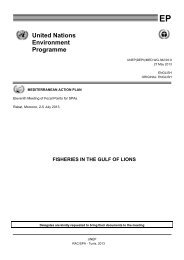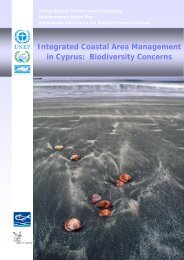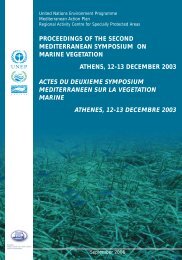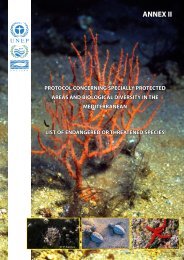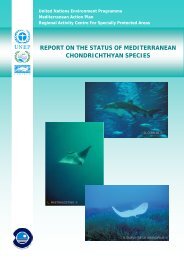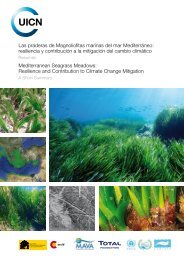Plan d'Action pour la conservation des espèces d'oiseaux inscrites ...
Plan d'Action pour la conservation des espèces d'oiseaux inscrites ...
Plan d'Action pour la conservation des espèces d'oiseaux inscrites ...
Create successful ePaper yourself
Turn your PDF publications into a flip-book with our unique Google optimized e-Paper software.
A <strong>la</strong>rge-scale study programme, using individualised p<strong>la</strong>stic rings, is<br />
under way, and promises to provide a much better understanding of<br />
the species’ movements within the Mediterranean, of exchanges with<br />
other nesting popu<strong>la</strong>tions in Africa and Asia, of survival rates and of life<br />
expectancy. This programme is to devote greater attention in future to<br />
wintering areas on the southern shores of the Mediterranean.<br />
3. Lesser Crested Tern Sterna bengalensis<br />
Terns (or “sea-swallows”) are very graceful fish-eating birds, which nest<br />
on the ground on beaches or the edges of coastal <strong>la</strong>goons. In the case<br />
of the Lesser Crested Tern, we are dealing with the Mediterranean<br />
popu<strong>la</strong>tion (considered as an endemic sub-species) of a species<br />
widely distributed through Africa and Asia. The nesting area of the<br />
great majority of this popu<strong>la</strong>tion is on two small is<strong>la</strong>nds in the tidal zone<br />
off the Libyan coast, which are therefore the priority area for any<br />
<strong>conservation</strong> action for this species; it does also nest in other<br />
Mediterranean countries, generally in colonies of other tern species,<br />
particu<strong>la</strong>rly in France, Italy and Spain, where its numbers are showing a<br />
tendency to increase. The wintering areas are poorly known and are<br />
probably located off the eastern and western coasts of Africa.<br />
4. Sandwich Tern Sterna sandvicensis<br />
The Sandwich Tern (so called because it was first <strong>des</strong>cribed in the<br />
English town of Sandwich) has a broad world distribution. In the<br />
Mediterranean a limited number (probably less than 3,000 pairs) nest<br />
on the ground in deltas, coastal <strong>la</strong>goons and salt-pans; much <strong>la</strong>rger<br />
numbers arrive from the north to winter in the Mediterranean region.<br />
The priority is therefore to conserve the nesting popu<strong>la</strong>tions, but also to<br />
guarantee safe wintering sites for other popu<strong>la</strong>tions. The species is<br />
listed on Annex I of the European Union’s Directive on Wild Birds.<br />
5. Little Tern Sterna albifrons<br />
The Little Tern is the smallest of the terns; it comes to nest in the<br />
Mediterranean and returns to winter along the eastern and western<br />
coasts of Africa; while it is still fairly widely distributed as a nesting<br />
species, its numbers have decreased a<strong>la</strong>rmingly almost everywhere,<br />
above all because of tourist developments along its nesting beaches.<br />
Since it is more wi<strong>des</strong>pread than other terns, detailed inventories of its<br />
colonies are <strong>la</strong>cking and little information is avai<strong>la</strong>ble on its numbers. It<br />
is included on the European Union’s Directive on Wild Birds.<br />
75




